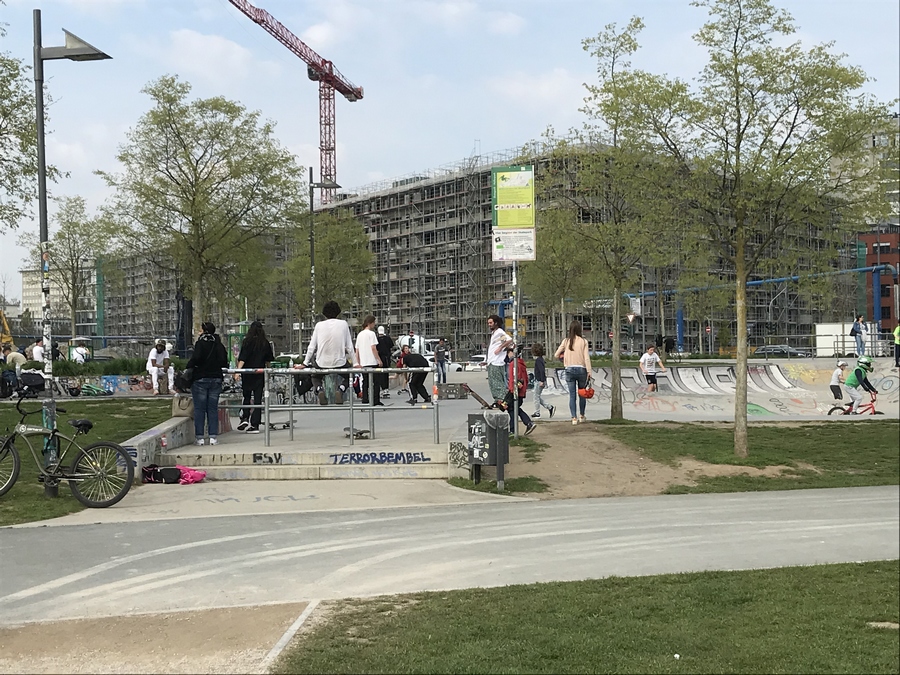bdla demands maintenance and development of urban green spaces at a high level
Especially in times of the pandemic, well-maintained public green spaces that can be used in a variety of ways are system-relevant for the health of urban society. Politicians and administrators are called upon to provide the necessary financial resources for the maintenance and development of municipal green spaces on a permanent basis.
Current situation
- The pandemic significantly increases the number of visitors to urban green spaces; the already heavily used urban green spaces are put under additional strain.
- Families and young people in particular find urban green spaces more important than ever.
- Green spaces provide necessary relief from cramped living conditions. Especially dense and disadvantaged urban quarters must be provided with sufficient green spaces.
- Green spaces increase psychosocial resilience in cities as well as climate resilience.
- Only well-maintained green spaces can withstand the pressure of use and be permanently preserved.
Don't save at the wrong end
- Urban budgets must provide more money for the maintenance of green spaces, but also for their expansion.
- Poor maintenance destroys values and substance, positive effects are reduced.
- Even when the budget is under pressure, savings must not be made on green spaces. This would be at the expense of physical and mental health prevention.
- Municipalities must also be strengthened financially for this reason.
Green space use and health prevention
Green spaces have always been among the most intensively and widely used public facilities in cities. Up to 95 percent of the population uses them, most of them frequently. Green spaces are places for people to meet and make a significant contribution to urban culture. Well-designed and maintained parks are as much an expression of culture as other works of art, whether historic or contemporary. They are important not only for the local population, but increasingly also for tourists.

The frequency of visits to public green spaces and open spaces has increased significantly since the beginning of the Corona pandemic. Even the smallest green corners are used intensively. This is not only shown by sight and personal experience, but also by empirical studies. For almost 50 percent of citizens, green spaces have gained in importance during the pandemic, and almost 30 percent visit them more often than before. At the same time, however, already existing deficits in the care and maintenance of many green spaces are worsening: according to a representative Forsa survey from 2021, up to a quarter of respondents complain about the condition of the facilities(survey commissioned by the BGL initiative "Green in the City").
The increased attribution of importance and the rising number of visits clearly show that green spaces are not only important for biodiversity, ecology and climate adaptation of a city, but at the same time for the psycho-social resilience of the population - especially in times of pandemic-related restrictions. Families who have to manage home office, school and normal life in a limited space are dependent on alternative options, if possible in the immediate residential environment. Public green spaces are highly valued by young people and families with children, underpins the aforementioned survey. It is therefore in the interest of both environmental and social justice to ensure a high quality and quantity of public green space.
Maintenance and development of public greenspaces
As a consequence of this development, a trend reversal in municipal green space maintenance is necessary. In recent decades, this area has been the "piggy bank" of municipalities, although green spaces were and are the most used public (cultural) facilities in cities. Currently, it is feared that the public budgets will be permanently burdened by the Corona pandemic. But this must not be at the expense of the care and maintenance of public green spaces. This is another reason why the municipalities urgently need to be relieved financially.
If green spaces are not maintained, they drastically lose their usability, climate effectiveness and quality, and thus their value. Trees die in drought, freshly planted trees do not grow. A newly planted tree costs between 600 € (in the park) and up to 2000 € (street trees). If they are not cared for, especially watered, investments are senselessly destroyed.
Already in the 19th century, pandemics were the reason to improve the supply of public greenery in many cities, e.g. at the time of the cholera in New York (Olmstead, Central Park) and Paris (Hausmann's Boulevards) and the Spanish flu after the First World War, e.g. in Mumbai and Melbourne. Also in Germany, especially in Berlin, it was recognized towards the end of the 19th century that for a healthy population more green spaces and spaces for exercise had to be created (Arminius, Martin Wagner and the sanitary green of cities). In recent decades, the importance for mental health has also become increasingly known (e.g. "Stress And The City" by Mazda Adli).
The (over-) quality of life of our cities depends on strengthening their green and open spaces. The maintenance of existing green spaces needs to be improved and underserved urban neighbourhoods need to be better equipped to meet current and future challenges of an economic, ecological and social nature.
On the topic: MDR podcast "Corona- and then? Urban green spaces against climate change", Prof. Catrin Schmidt, landscape architect bdla, TU Dresden on the importance of urban green spaces in the Corona era
- Latitude: 0
- Longitude: 0


